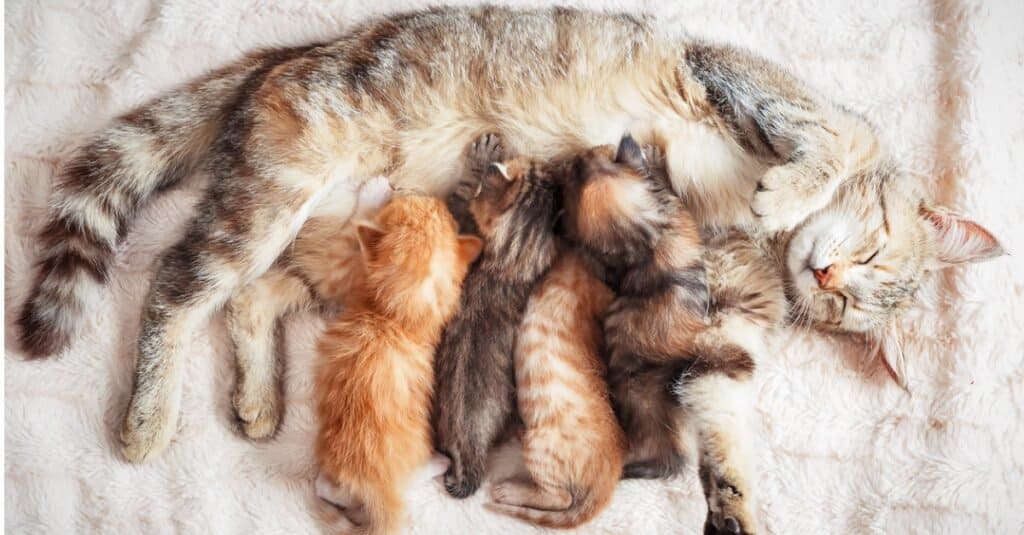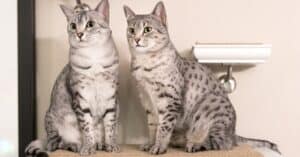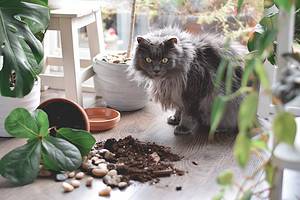If you’ve ever been woken in the night to the screaming of cats outside, maybe you’re hearing a neighborhood cat duel, or maybe those felines are just feeling frisky. Cats on the procreation prowl tend to get a little loud. A queen is the name for a female cat, while their male suitors are toms. If you’re the parent of a pet cat, it’s important to know what age they sexually mature and when the season for mating begins. Whether you’re considering a pet cat, want to know how to avoid pregnancy for your pet, or are just curious, read on to find out all about cat mating season. When do cats breed?
When is Cat Mating Season?

Cats mate when the queen is receptive. This can happen year-round but peaks in the spring.
©sophiecat/Shutterstock.com
Cat mating season is nearly year-round, with peak breeding occurring in early spring through summer. Indoor cats and those in warm climates are more likely to come into heat year-round. The mating season varies depending on the environment. It can be brought on by long hours of daylight, warm temperatures, and the presence of other cats.
While the tomcat is always ready for mating, the queen will only be available during her reproductive cycles. During the breeding season, most go into this heat cycle every three weeks, but each cat has her own pattern, which will usually repeat each spring or fall. An article in the Journal of the American Veterinary Medical Association found cats that were pregnant in all months of the year, but the percentage was highest in March, April, and May.
The Cycle of the Queen

The estrus cycle leads to pregnancy if mating is successful.
©iStock.com/bozhdb
The queen or female cat goes into periods of receptiveness to mating called estrus, or heat cycles. They’re polyestrous, meaning that they come into heat regularly during their reproductive years. The heat cycles for a cat typically begin at the age of 6 months but as early as 4 months and last until she’s spayed or bred. This estrus period can last for days to weeks and may repeat every two to three weeks. The average length per cycle is 6 days. Cats are able to mate during any part of their heat cycle. They’re induced ovulators, meaning that the act of breeding triggers them to release eggs in order for pregnancy to occur. Some may need 3 to 4 matings to initiate ovulation and get pregnant.
Cats in Heat- The 4 Stages:
- Proestrus: This is the phase of courtship that lasts one to three days. The queen is more affectionate and vocal. Her appetite varies during this time, and she’ll often attract male cats to the house with her smell and vocalizations. She’s not ready for breeding in this short phase, so while she’ll rally the neighborhood tomcats, she’ll refuse to mate just yet.
- Estrus: This mating phase is also called in heat or standing heat. It’s typically 3 to 5 days if bred or 14 days if mating does not occur. A female cat will cry loudly, rub against people and furniture and shake and roll her body on the floor. If stroked on the back near the tail, she’ll squat, raise her hindquarters and tread her feet while switching her tail in a posture called lordosis. If indoors, she’ll be persistent in trying to leave the house to find a tomcat.
- Metestrus: This phase usually lasts 24 hours. It’s a time when the queen will still be displaying estrus behaviors, but refusing tomcat advances. What happens next is a 58 to 70-day pregnancy if she was successfully bred or a 7 to 28-day period of sexual rest if she did not mate. Although rare, a shorter false pregnancy of 30 to 45 days may take place if she was sterilely mated. This is difficult to tell from a real pregnancy as she’ll show similar signs, with enlarged mammary glands, increased appetite, and nesting behaviors.
- Anestrus: This is a time period of rest when the female cat is not in heat. If a spaying surgery will be performed, this is the time to do it.
Cat Mating Season Behavioral Changes

Meows, howls, and caterwauls announce that cat mating season is here.
©BeansproutP/Shutterstock.com
During mating season, both queens and toms will be anxious to get outside more often. We’ve already discussed the behaviors of queens and their vocalizations which may range from soft purring to loud and throaty caterwauls, a shrill howling. When a queen is ready to mate, she’ll let everyone know it.
Males also get vocal during mating season. Tomcats meow and howl loudly and frequently during this time, especially in the evening. This behavior calls out to the queens to let them know that he’s nearby and ready to mate. Males typically mature between 7 and 12 months old. They go through a springtime excitement during which they might spray urine frequently. They do this while backing into vertical objects and tread their hind legs while switching their tails. Their urine contains pheromonal messages that signal reproductive status to potential mates. Outdoor male cats are likely to get into more fights during this time. When tomcats pick up the smell and vocalization cues of fertile females, they’ll assemble around her and engage in noisy fights with rivals.
Mating, Pregnancy, and Birth

Mother cats nurture their young, nursing the litter until they’re ready for weaning.
©Bogdan Sonjachnyj/Shutterstock.com
When cats mate, it’s generally a short and loud affair. The male’s reproductive organs are barbed, which is thought to stimulate ovulation in the female. This is an effective strategy but is likely to cause the female pain. You might see her lash out with a swat at her tomcat post-copulation. They’ll then separate to groom themselves. A queen will sometimes mate with many different males during her cycle, so litters of kittens with different fathers are possible.
Once bred, cats will be pregnant for 58 to 70 days, an average of nine weeks. They don’t usually show signs of pregnancy until they’re a few weeks into their term. Cats give birth to 1 to 12 kittens in a litter. This varies by breed, but the average litter is 4 kittens. The males do not normally participate in the raising of offspring. As mammals, the mother cat will nurse her young and may begin the weaning process around 4 weeks, but sometimes provides milk for her young ones for up to 12 weeks.
The photo featured at the top of this post is © iStock.com/Tylinek
Thank you for reading! Have some feedback for us? Contact the AZ Animals editorial team.






